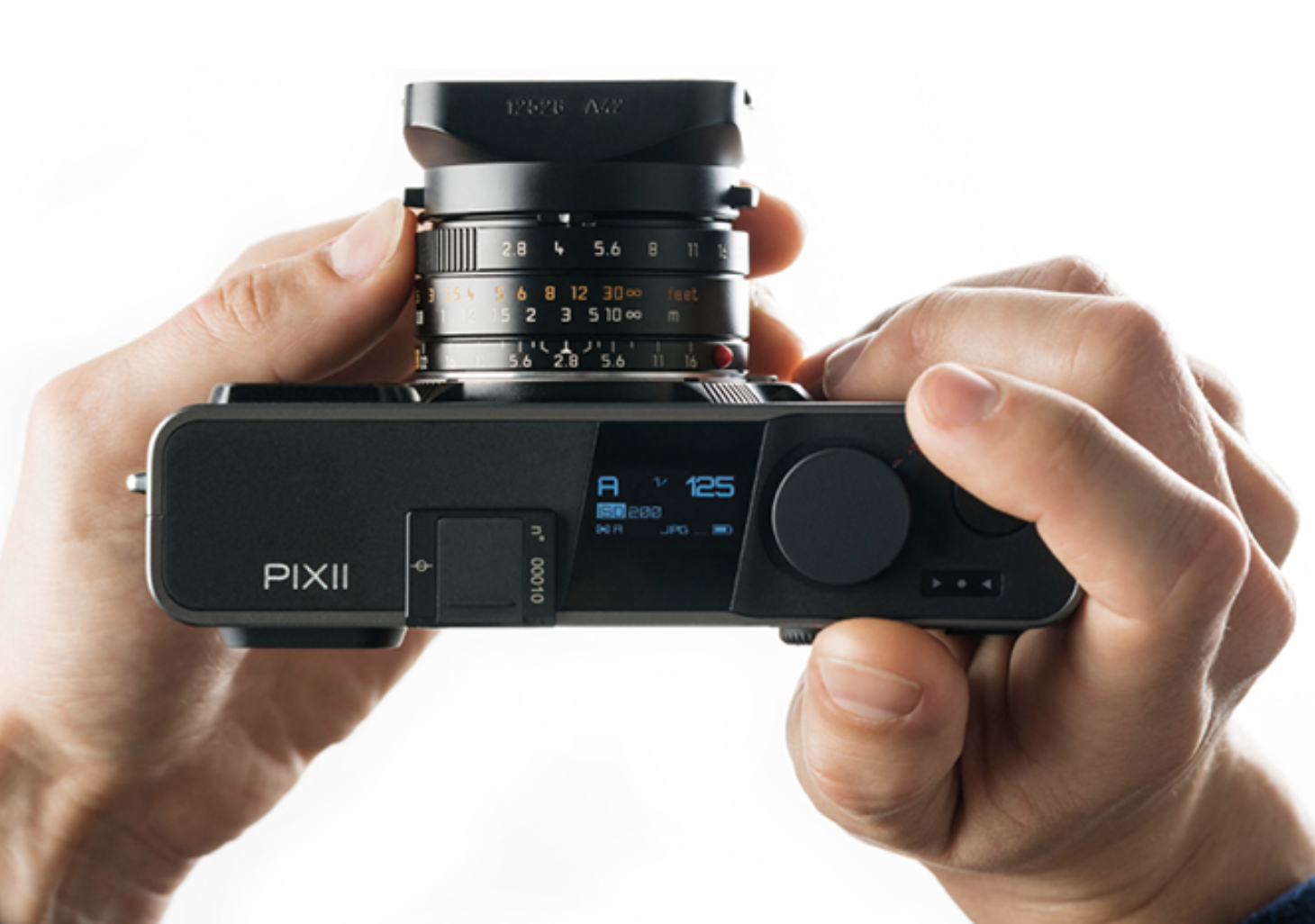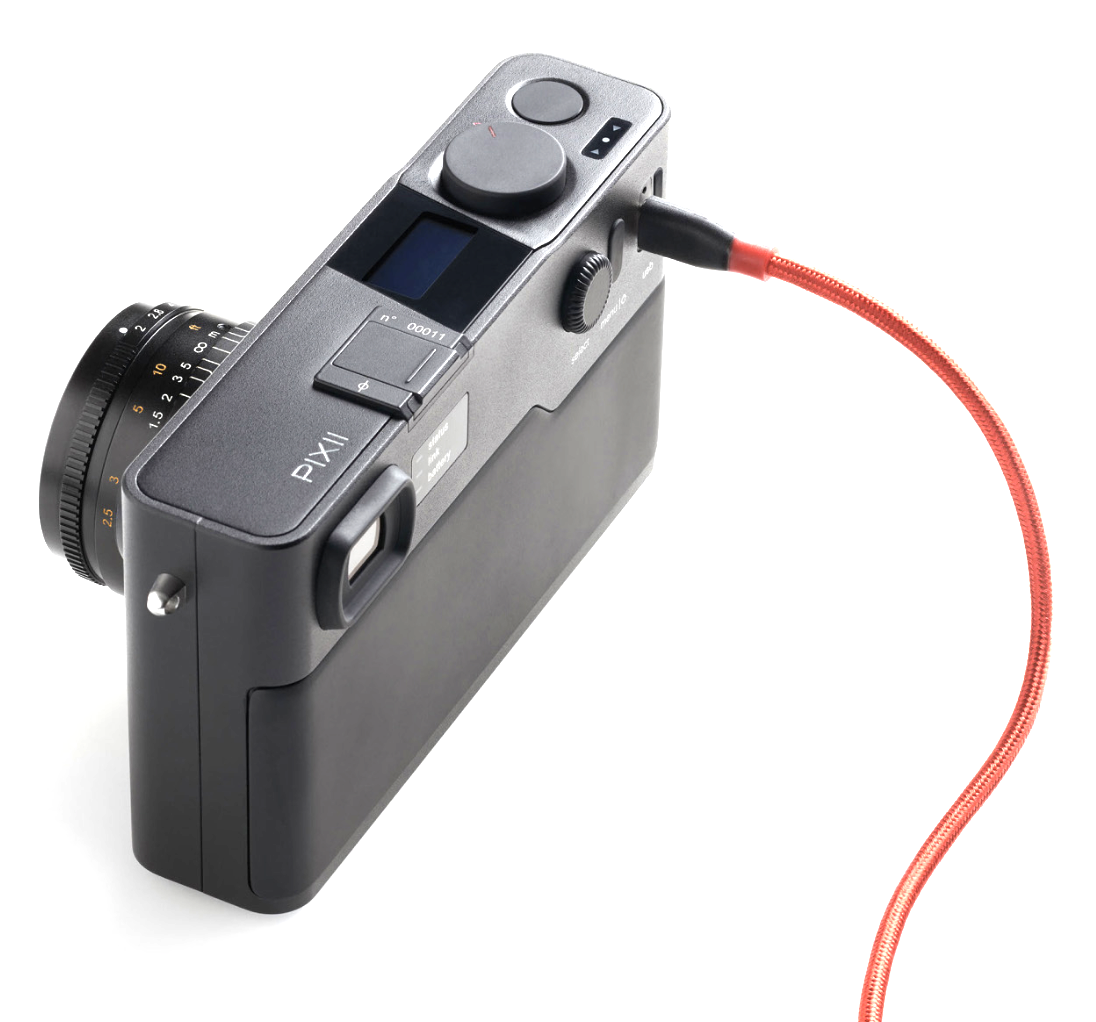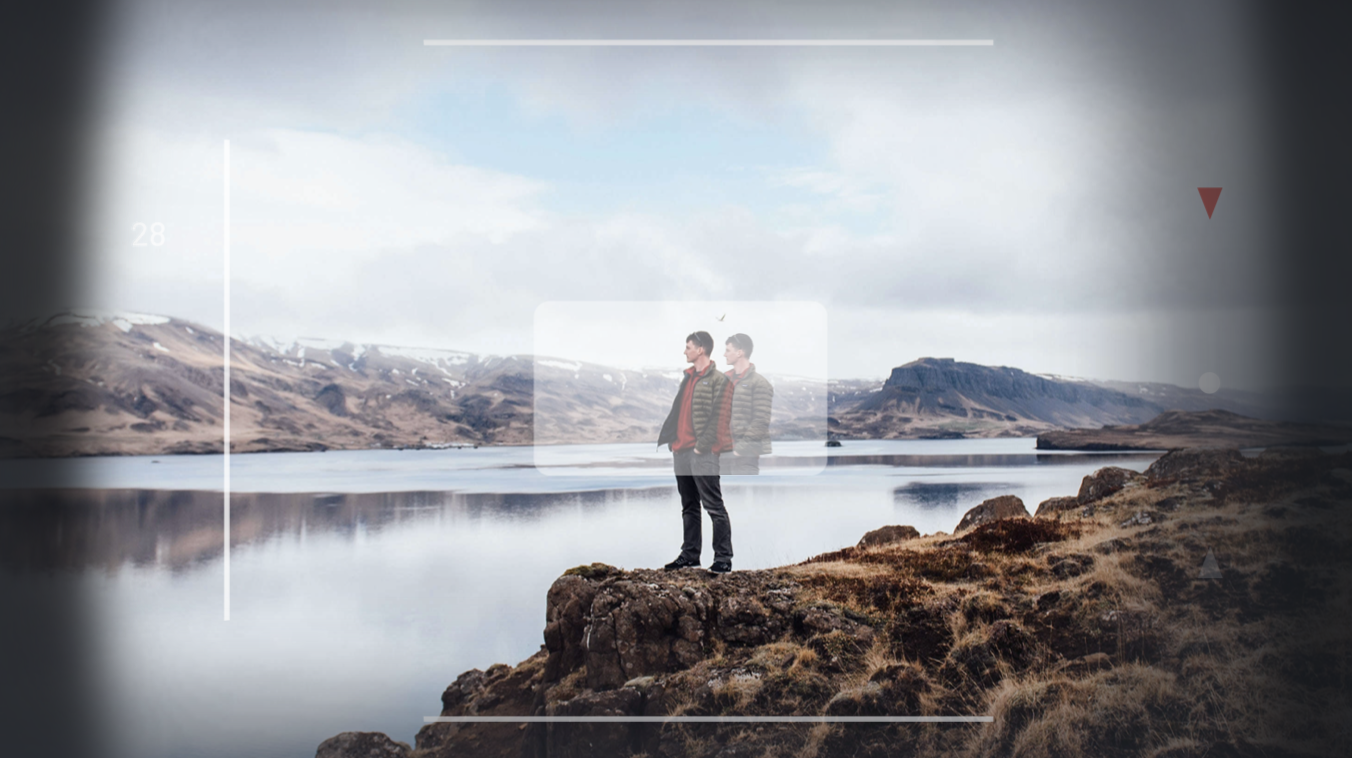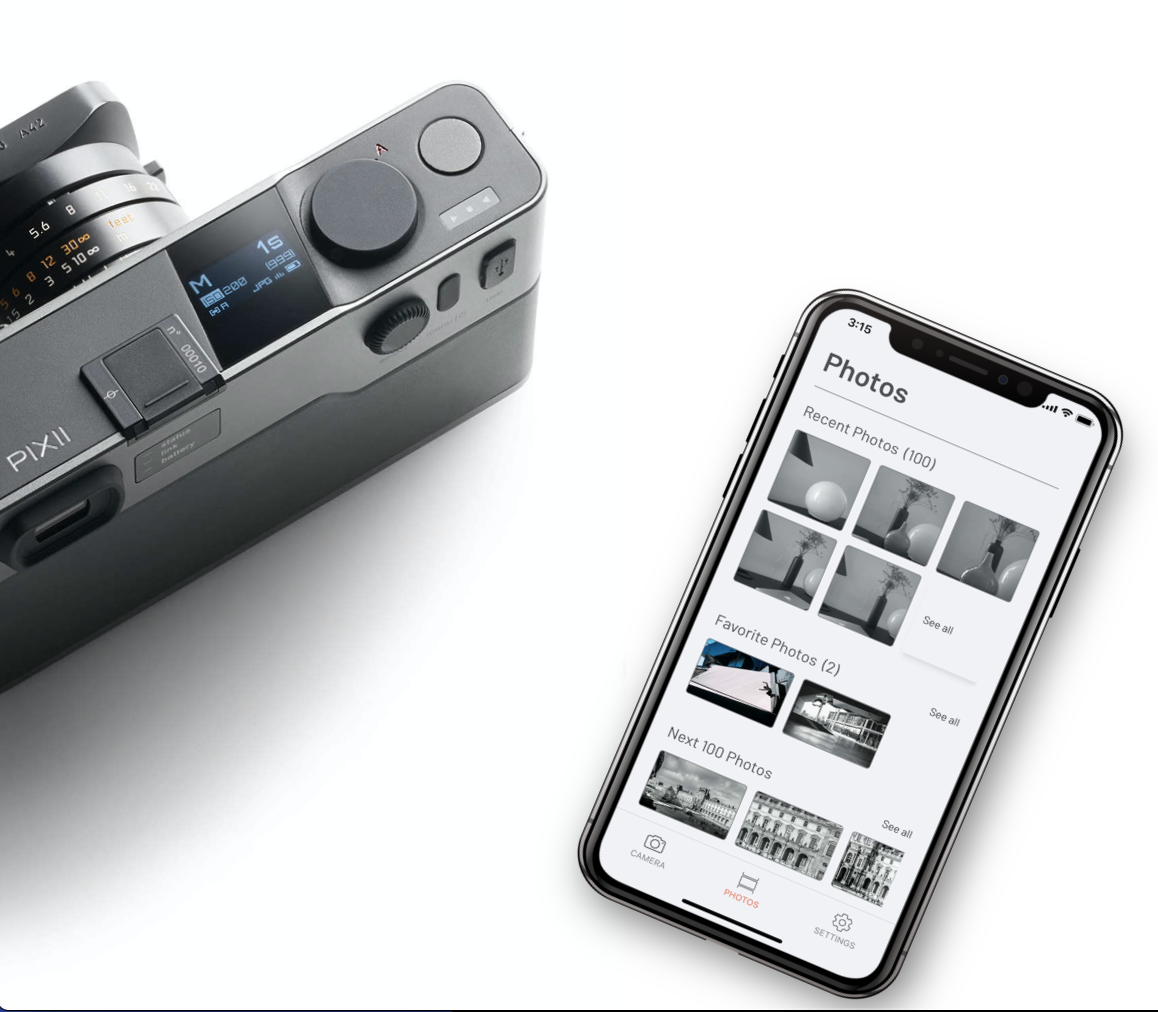The long-rumoured Pixii M-mount camera is here and you can order one today. It has a screenless body with an APS-C crop sensor and adopts a minimalist approach that will appeal particularly to the traditional M user.
Above all other considerations, it is the native M-mount which will sell this camera. There is no need for expensive adapters, saving both cash and up to 300g of weight. More to the point, though, the absence of an adapter removes bulk and means that this small body will perfectly match Leica’s compact lenses. Imagine the Pixii with Leica’s smallest lens, the 28mm Summaron, attached. I can appreciate that immediately.

Simplicity
The camera appears to be well designed, with a degree of simplicity clearly aimed at the traditional M user. It features a true rangefinder focus system, apparently very similar to that in Leica models. However, the manufacturers place great emphasis (perhaps too much emphasis) on integration with smartphones. Images are transmitted to your phone immediately but you can transfer RAW files later if you wish.

This is a camera that is designed specifically to work with your smartphone and you are expected to use the phone as a primary interface. Nevertheless, there is always a mismatch in my mind between rangefinder camera and smartphones. Rangefinder users typically prefer a more analogue approach to photography.
Reinforcing this reliance on external electronic support is the lack of removable storage. This is perhaps the major flaw and, for many, it will be a dealbreaker. Instead, the Pixii makes do with internal storage of 8GB or 32GB, although a cheaper launch model will offer just 4GB. I think many potential buyers, attracted primarily by the direct compatibility with M lenses, will be disappointed by this reliance on smartphone integration. It’s a pity and it’s hard to understand why an SD card slot couldn’t have been integrated.
M10-D market
In many ways, this camera appeals to the same market as the Leica M10-D, although Leica takes an entirely different approach to usability, emphasising the practical simplicity and playing down the smartphone connection. Yet we have to face the fact that the M10-D is a niche product for Leica and I sometimes wonder if it makes commercial sense.
The M10-D is a camera that can be used very effectively in isolation. That’s how I regard it, as a sort of digital film device. Smartphone connectivity is available via the FOTOS app, but as an M10-D owner, I use FOTOS only for camera set-up purposes. Basically, that means that in all the time I’ve owned the M10-D I have used FOTOS maybe a couple of times.
With the Pixii, however, you’d better get used to using your smartphone as a necessary adjunct to the camera. I don’t think I could accept that.
The rangefinder itself, though, is intriguing:
Pixii is equipped with a high precision optical device connecting the lens and the viewfinder. A small mechanical wheel precisely senses the advance of the lens optical group. It translates the movement of the lens into a subtle displacement of the rangefinder image projected onto the viewfinder. You can measure any distance between a nearby object at 70cm up to the moon distance, close to infinity. The distance conversion ranges from less than 4mm at the back of the lens into a tiny millimetre change inside the rangefinder. The resolving power of your eye does the rest.

Despite some reservations about the market for such a camera, the Pixii does tick two important boxes. First, it needs no adapters; second, it is a rangefinder. I think it will find a niche market, although hard-headed enthusiasts will say that the TL or CL can do a similar job at less cost, even with the disadvantage of having to use an adapter. Nor should we forget that some users actually prefer an electronic viewfinder to the rangefinder, particularly those with ageing eyesight.
A crop too far?
When this Pixii was first mooted a couple of years ago, it never occurred to me that it wouldn’t have a full-frame sensor. The crop sensor with an odd density of 12MP is, therefore, something of a disappointment, especially for lovers of wide-angle photography who may not currently own ultra-wide lenses.
For most people, with their 28mm Elmarits or 35mm Summicrons, the 1.5x crop factor is going to be a problem. To get their favourite focal lengths they will have to invest in ultra-wide M-mount lenses. However, on the other side of the coin, standard 35mm and 50mm M lenses take on a new and potentially useful guise as 50s or 75s.
Another curiosity about the Pixii is the all-electronic shutter. This, again, is something that might not release the creative juices of a typical rangefinder enthusiast.
The 8GB Pixii will sell direct for €2,900 (£2,625, $3,275). I can see no price listed for the 32GB version, but the limited launch edition, with its 4GB internal storage, is listed at €2,700 (£2,440, $3,050). These prices do not include tax, so European buyers can add 20 percent.
I hope to have the chance to try a Pixii in the future. In the meantime, my friend Hamish Gill over at 35mmc.com has already had his hands on a beta version and he expects to have a production Pixii soon. If you are interested in this camera, his initial views are worth reading.

My thoughts are mixed. I find the concept of the Pixii immensely appealing. But then, as an M10-D convert, I can really appreciate the lack of a screen and regard this absence as real benefit rather than a disadvantage.
The lack of SD-card storage is a significant disadvantage, however, and I suspect many in the target audience will also think the same. Never the less, there is no denying that this is an ingenious and exciting little camera that will pique the interest of all Leica owners. Whether or not they will buy, however, is another matter.
The price of the Pixii is a bit steep for an APS-C body, of course, but this is perhaps no surprise given the integration of a proper mechanical rangefinder. The rangefinder mechanism alone accounts for around a sixth of the total cost of a Leica M digital, so a precision device of this nature is never going to come cheap. For the moment, I give the Pixii a qualified thumbs-up. At the very least, it is a welcome addition and an intriguing concept. We will have to wait for some real-world reviews to find out how it performs.
You can find all the details of the camera on the Pixii website.

There are a lot of good insights here, but you seem to be missing the key point. This isn’t intended to be a “French Leica”… it is designed for a completely different kind of customer than the old, rich, analog-wannabe traditionalists who buy most of the M10s sold. It is intended for people who care about making photos but for whom a cell phone is a natural extension of the body… for whom the instinctive response to the (misleading) term “full-frame” is “full of what?”… who respect the great images of the past but don’t care about the mechanics of how they were made, any more than they would care about driving Robert Frank’s car or using Cartier-Bresson’s toothpaste.
It’s spelled out pretty explicitly on PIXII’s website: “This is the end of the line for the digital camera designed in the 80s: a sensor, a CPU and a screen. All of these components were necessary back then. Because computers were rare and hard to use. Except it’s 2020 now. Who seriously needs a fixed function computer and a bad LCD at the back of a camera? Pixii is the fusion of 2 essential elements: the physical camera body and the software, virtualized into an app, that dynamically develops the picture on a screen.”
In other words, the PIXII isn’t a rangefinder camera because the company wants to appeal to Leica-revering traditionalists; it’s because a range/viewfinder is a proven way to aim and focus a camera without using onboard imaging electronics. It doesn’t have an M mount so you can use Grandpa’s Dual-Range Summicron; it’s because it’s a well-established, adaptable mount for rangefinder-coupled lenses.
Quoting the PIXII website again: “… the traditional camera market has collapsed. Was it killed by the smartphone? No, photographers just aren’t interested in old cameras anymore.”
If your thinking is defined by the concepts that drove the design of old cameras, you won’t “get” the PIXII at all. But if you think about it in its own context, it might make more sense.
No, I won’t be buying a PIXII… I simply don’t have enough disposable income. I live in the USA, where government policy is to concentrate more and more of the nation’s wealth in the hands of fewer and fewer extremely rich people, so my days of buying expensive cameras are basically over. But I think I do “get” the concept, and I’m excited by the idea of a manufacturer thinking about cameras and photography in a different way.
Lots of valid points here, JL, and I sincerely hope that your assessment is right and that people do buy the PIXII. It’s good to have a new entrant in the market and your observations could well be spot on in relation to the intended target market.
Perhaps one needs to change brain software to get all that: asking for too much to someone who just wants to take good photographs at a reasonable price. Fortunately anyhow the end of 1980’s cameras, if they ever existed.
I agree with JL. I can’t imagine my offspring and their ilk wanting to deal with memory cards. The phone is an appendage, non-optional. They watch me moving cards into editing software and dealing with backups and all the stuff that goes with it. Share it? Post it? Wait, let me tweak it some more, export it to a form I can upload that won’t break the megapixel bank at the other end…
They smile wryly, thinking the geyser has lost reality (again). How quaint. Of course, when they are out of mobile signal range they begin to twitch uncontrollably. The value of an SD card at that moment is lost on them. That’s what RAM in the phone is for, but, of course, it’s full and usually dumps to the cloud- except when it can’t.
I see the need for cameras and phone equivalent simplicity- read sharing- to converge. I think Dr. Kaufman made the remark that it’s critical to have a strategy to get the photos out fast (that attention span thing), hence Leica Fotos. I have it, but I find for me it’s just too clumsy and time consuming. Maybe someday. Some value for tripod mounted shots at odd angles. I do shudder at the shear megapixel count relative to my data plan ($$$)- maybe that’s why the Pixii is 11 Mpx? Keep file and data cost manageable, mobile network wise, and reduce the battery hit of the phone-camera always on link? And APS-C is way larger than any phone sensor, so no contest there.
My SL2 traded the onboard gps for a phone hosted gps link. I don’t use it- keeping that link live to my phone sucks the SL2 battery down far faster than the onboard gps on my now parted SL(1).
Like JL, I live in the USA, and maybe my thinking is impacted by the current bizarre reality distortion field (nod to Steve Jobs) that exists here now. I was just reading an article posting connections to ‘Pharmacy Advisors’ for $125 US / hour for help to get insurance companies to at least partly pay for prescriptions. Formularies have dropped 300+ more drugs this year. Meds above $1700- of which there are many- the suggestion is to first try Advisors, but move on to lawyers. How to double, triple or quadruple the price of an already bad situation. And here I am saving the article. That tells you where my head is at. Take what I say with a grain of salt. Better yet, buy a Pixii- it’s a deal.
I’m not quite of the ‘this is bonkers’ persuasion. Maybe I’ll settle for ‘this doesn’t quite add up’? By that I mean there has been a lot of development money spent in some areas — e.g., a global shutter CMOS sensor (not CCD), the fully mechanical rangefinder and seemless wifi integration to your phone. But are they the areas that people are interested in spending that amount of money?
If I may use a Top Gear analogy, is this the camera world’s equivalent of the lightweight sports car built in a shed in Norfolk that you’d like to see take on the big guys but you know won’t make 10 laps of the track with Stig at the wheel?
It might also be a good idea to ask Leica just how many M-Ds they’ve sold. I am it’s greatest proponent (I imagine) but it can’t make a lot of commercial sense, even as an adjunct to the main range.
I wonder who will recalibrate the rangefinder when they go out of business?
I was laughing so hard when I read the the details on this relatively expensive camera I had to wait awhile to comment. I cannot do better than Peter’s opening comment “This is bonkers”!
I thought your article was going to be about the Cottingley Fairies, Mike. I have no interest in these cameras, but a communications function will be necessary for the future survival of the ‘camera race’. The Leica FOTOS app and other similar ones do not fill that gap. I cannot see anything inhibiting the development of inbuilt wireless or some other newer technologies in cameras. One of these days there will be a real game changer digital camera. This one is not it, but it seems to me that most digital cameras these days are operating with technology that seems to be at least 20 years old behind the possibilities of today’s technologies. Someday we might see a ‘great leap forward’. I’m not waiting. I am going back to film just for the thrill of it.
William
A very expensive purist toy.
It is indeed. I wonder what the general reaction would have been if Leica had made this? Probably more positive, but your basic assessment is spot on.
Thanks
I would have liked a more economic and simple M Leica in other times. Now I enjoy many of the advantages of evf and auto focus, that can be shared with manual lenses with an adapter. They kept on the tough M concept though.
I love rangefinder and viewing for real, but not to be tightened to that short minded result.
Peter’s “absolute bonkers” neatly summarises the Pixii for me. For me it looks about as useful as a chocolate teapot or an ashtray on a motorcycle.
Hopefully the venture investors have not remortaged their homes or sold any of their kidneys or small children to get this weird device into production.
It’s a shame but perhaps understandable that Leica might have done a quid pro quo with the Pixii people to avoid being the “next generation” Leica M.
You can have our M mount but…
Must be an APSC format sensor.
Must not have a memory bigger than…
Must be tethered to a smart phone to change functions.
Etc.
I hope it’s not the case but you have to ask if you were designing a rangefinder camera would you throttle its potential this way?
The 8GB version is now sold out leaving only the 4GB launch edition left — the 32GB version mentioned in the review above is not listed.
Oh and those prices are exclusive of tax — add 20% at checkout for those in the EU…
Thanks for this update, Steve. I will amend the article. That extra 20% just about does it!
The problem is with VAT it is almost the price of a new M 262 and CL does it all at a much cheaper price with added option of using auto focus lenses if one desired. The saving grace might be micro lenses that are there on this camera.
I largely agree with this review. But would sum it up as follows. The optical rangefinder and M-mount are good decisions. Would prefer mechanical shutter. I could live with the internal storage. The necessity of using smartphone is a no-go; a camera should be entirely usable on its own.
Even the hidden settings in Leica M10-D that must be adjusted by smartphone are a negative to me. If there are going to be hidden settings, I wish Leica would also offer a curses-based terminal application to adjust the hidden settings; this seems a great fit to me for the spirit of the camera.
Doesn’t the t,tl do the same for memory if u forget your card? Also wasn’t bigger memory promised in that Zeiss that I have yet to read been released, maybe COVID made Zeiss change their mind. Going go read Hamish, should be enlightening like Jonos. Thanks Mike.
Yes, the TL and some other cameras have reasonable internal storage but I can’t think of another camera that doesn’t also have a card slot. Seems a pointless omission to me; presumably it wouldn’t have added much to the production cost and it would have answered this major criticism. It would have given buyers flexibility instead of having to decide upfront how much storage they think they might need.
Absolutely bonkers. The lack of removable storage just kills it for me, especially at that price. I have a phone for telephoning, and the idea that one device (camera) which presumably has a removable and rechargeable battery (though I can’t see that stated anywhere) is in large degree dependent on dumping photos to another, which usually has an onboard battery that runs down PDQ, just doesn’t appeal. Otherwise it does have some attractions for me.
Mike, you manage a remarkably sympathetic review despite your obvious ambivalence and reservations. Developing the package as owner-user would of course allow for other M-lenses than Leica’s, which might make more sense. I personally dislike smartphones, so it’s a non-starter for me, but it will be interesting to see the first images appearing on Macfilos.